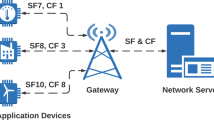Abstract
LoRa is a low-power wide area network technology capable of delivering data over very long distances. Due to its wider range, a LoRa network may be subject to a higher probability of packet collisions when deployed with a large number of end devices. To help LoRa network planners analyze the performance in terms of packet losses, and adjust communication parameters to improve reliability, a proper mathematical model is needed. In this paper, we develop a packet loss model that takes into account individual end devices’ packet arrival rates, transmission powers, and distances from a gateway. The derived model is applied to an optimization problem to find appropriate transmission powers in form of a linear program. Experiments show that packet loss probabilities predicted by the model mostly conform with the results from simulations and the model accurately predicts the aggregated interference, along with the expected loss rate, under moderate to heavy data traffic. In addition, the proposed optimization technique allows lowering the overall transmission powers while maintaining comparable signal-to-interference ratio and packet loss rate.









Similar content being viewed by others
References
Abdelfadeel KQ, Cionca V, Pesch D. Fair adaptive data rate allocation and power control in lorawan. In: 2018 IEEE 19th international symposium on “A world of wireless, mobile and multimedia networks” (WoWMoM); 2018. p. 14–15. https://doi.org/10.1109/WoWMoM.2018.8449737.
Adelantado F, Vilajosana X, Tuset-Peiro P, Martinez B, Melia-Segui J, Watteyne T. Understanding the limits of lorawan. IEEE Commun Mag. 2017;55(9):34–40. https://doi.org/10.1109/MCOM.2017.1600613.
Billingsley PP. Probability and measure. 2nd ed. New York: Wiley; 1986. p. 371.
Bor M, Roedig U. Lora transmission parameter selection. In: 2017 13th International conference on distributed computing in sensor systems (DCOSS); 2017. p. 27–34. https://doi.org/10.1109/DCOSS.2017.10.
Bor M, Vidler J, Roedig U. Lora for the internet of things. In: Proceedings of the 2016 international conference on embedded wireless systems and networks, EWSN ’16. Kimble County: Junction Publishing; 2016. p. 361–366.
Bor M, Roedig U, Voigt T, Alonso J. Do lora low-power wide-area networks scale? In: Proceedings of the 19th ACM International Conference on Modeling, Analysis and Simulation of Wireless and Mobile Systems, MSWiM ’16, p.59–67. New York: Association for Computing Machinery; 2016. p. 59–67. https://doi.org/10.1145/2988287.2989163.
Centenaro M, Vangelista L, Zanella A, Zorzi M. Long-range communications in unlicensed bands: the rising stars in the IoT and smart city scenarios. IEEE Wirel Commun. 2016;23(5):60–7. https://doi.org/10.1109/MWC.2016.7721743.
Friis HT. A note on a simple transmission formula. Proc IRE. 1946;34(5):254–6.
Goursaud C, Gorce JM. Dedicated networks for IoT: PHY/MAC state of the art and challenges. EAI Endorsed Transactions on Internet of Things. 2015;1(1). https://doi.org/10.4108/eai.26-10-2015.150597.
Li S, Raza U, Khan A. How agile is the adaptive data rate mechanism of LoRaWAN? In: 2018 IEEE Global Communications Conference (GLOBECOM); 2018. p. 206–212. https://doi.org/10.1109/GLOCOM.2018.8647469.
Li Z, Zozor S, Brossier J, Varsier N, Lampin Q. 2D time-frequency interference modelling using stochastic geometry for performance evaluation in low-power wide-area networks. In: 2017 IEEE International Conference on Communications (ICC); 2017. p. 1–7. https://doi.org/10.1109/ICC.2017.7996381.
Magrin D, Centenaro M, Vangelista L. Performance evaluation of LoRa networks in a smart city scenario. In: 2017 IEEE International Conference on Communications (ICC); 2017. p. 1–7. https://doi.org/10.1109/ICC.2017.7996384.
Mahmood A, Sisinni E, Guntupalli L, Rondón R, Hassan SA, Gidlund M. Scalability analysis of a LoRa network under imperfect orthogonality. IEEE Trans Ind Inform. 2019;15(3):1425–36. https://doi.org/10.1109/TII.2018.2864681.
Mitchell S, Consulting SM, Dunning I. Pulp: A linear programming toolkit for Python. 2011. http://www.optimization-online.org/DB_FILE/2011/09/3178.pdf. Accessed 28 Mar 2021.
Reynders B, Meert W, Pollin S. Power and spreading factor control in low power wide area networks. In: 2017 IEEE International Conference on Communications (ICC); 2017. p. 1–6. https://doi.org/10.1109/ICC.2017.7996380.
Sa-Ingthong J, Phonphoem A, Jansang A, Inkeaw S, Jaikaeo C. Long-Range data transfer system for telemetry equipment in areas with no cellular coverage (in Thai). In: 11th ECTI Conference on Application Research and Development (ECTI-CARD 2019), Ubon Ratchathani, Thailand; 2019.
Semtech. What are LoRa® and LoRaWAN®?. (n.d.). https://lora-developers.semtech.com/library/tech-papers-and-guides/lora-and-lorawan/. Accessed 10 Mar 2021.
Vaidya P. Speeding-up linear programming using fast matrix multiplication. In: 30th Annual Symposium on Foundations of Computer Science; 1989. p. 332–337. https://doi.org/10.1109/SFCS.1989.63499.
Acknowledgements
This research is supported in part by the Master degree scholarship from Faculty of Engineering, Kasetsart University and IWING laboratory research fund. Computing facilities for this research were supported by the Advancing Co-design of Integrated Strategies with Adaptation to Climate Change (ADAP-T) of the Japan International Collaboration Agency (JICA)/Japan Science and Technology Agency (JST) Science and Technology Research Partnership for Sustainable Development (SATREPS).
Author information
Authors and Affiliations
Corresponding author
Ethics declarations
Conflict of interest
The authors declare that they have no conflict of interest.
Additional information
Publisher's Note
Springer Nature remains neutral with regard to jurisdictional claims in published maps and institutional affiliations.
This article is part of the topical collection “Advanced Machine Learning Approaches in Cognitive Computing” guest edited by Kuntpong Woraratpanya and Phayung Meesad.
Rights and permissions
About this article
Cite this article
Sa-Ingthong, J., Phonphoem, A., Jansang, A. et al. Probabilistic Analysis and Optimization of Packet Losses in Dense LoRa Networks. SN COMPUT. SCI. 3, 25 (2022). https://doi.org/10.1007/s42979-021-00883-3
Received:
Accepted:
Published:
DOI: https://doi.org/10.1007/s42979-021-00883-3




